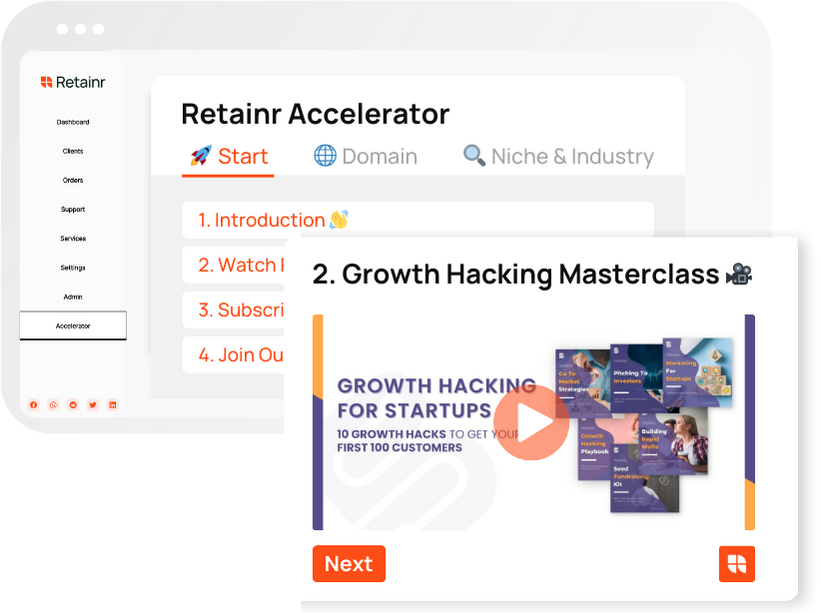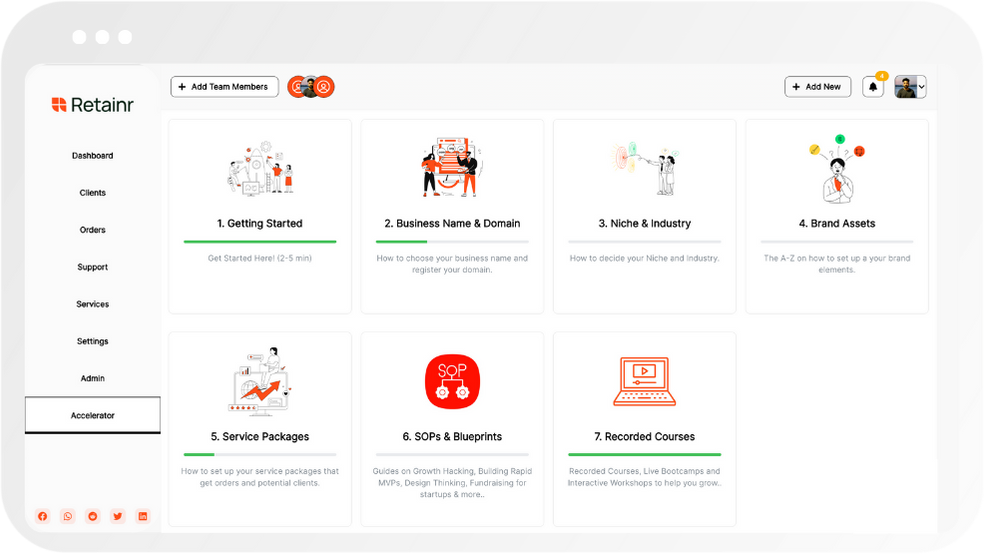
7 Expert Insights on Industry Analysis for Freelancers
Build with Retainr
Sell your products and services, manage clients, orders, payments, automate your client onboarding and management with your own branded web application.
Get Started1. What is industry analysis and why is it important for freelancers?
Understanding Industry Analysis
Industry analysis is a systematic review of the factors and trends that characterize a specific industry or market. The process involves studying market dynamics, patterns, changes, and potential growth areas. Some of the aspects examined include market size, competition intensity, trends, customer behavior, product or service distribution, legal aspects, and sociopolitical influences.
Fundamentally, an industry analysis aims to provide an in-depth understanding of the relative positioning of an industry and the competitive landscape within its environment. This type of research provides inputs for strategic decision-making when operating or planning to enter a specific industrial sector.
- Competitive Analysis: Determines the degree and nature of competition within an industry.
- Market Size Analysis: Identifies the size of the market potential.
- Trends: Reviews current and emerging tendencies within the industry.
Importance of Industry Analysis for Freelancers
An effective industry analysis is an essential strategic business tool for freelancers. It enables them to gain insights about the market environment, identify opportunities and threats, and make informed decisions to remain competitive.
Here are some reasons why industry analysis is crucial for freelancers:
- Identify Market Opportunities: Freelancers can explore new business opportunities, such as high-demand sectors and underserved markets.
- Understand Customer Needs: To tailor their services strategically to meet customer needs better, freelancers need to understand what those needs are.
- Analyze Competition: It helps to identify who their competitors are, what they're offering and how they can differentiate their services.
- Determine Pricing Strategy: Freelancers can establish competitive pricing based on industry norms and other key factors.
Industry Analysis Frameworks
The most commonly utilized models in industry analysis include Porter's Five Forces, PESTEL Analysis, and SWOT Analysis.
| Framework | Description |
|---|---|
| Porter's Five Forces | Assesses the competitive forces within the environment, including the threat of new entrants, bargaining power of buyers and suppliers, threat of substitute products or services, and the intensity of competitive rivalry. |
| PESTEL Analysis | Evaluates the larger macro-environmental factors that may affect the industry– Political, Economic, Sociocultural, Technological, Environmental, and Legal. |
| SWOT Analysis | This is a straightforward strategy tool that focuses on assessing the Strengths, Weaknesses, Opportunities, and Threats of an industry. |
2. As a freelancer, how do I perform an industry analysis?
Understanding Approach of Industry Analysis
Being a freelancer, it's important to understand the key concept of performing an industry analysis to stay competitive and productive in the market. This process of industry analysis is not vastly different from what businesses do. It includes:
- Identifying Industry Scope: Start by defining the industry you are involved in. For instance, if you are a graphic designer, your general industry might be 'design', with a precise niche in 'graphic design'.
- Identifying Competitors: In order to understand where you stand, identify your direct and indirect competitors, their strengths and weaknesses and what differentiates you from them.
- Analyzing Industry Trends & Predictions: Monitor recent trends, technological innovations, shifts in client preferences, and industry predictions.
Application of Tools for Industry Analysis
There are various tools and frameworks freelancers can use to aid their analysis which provide a structured way to look at the broader industry environment. Below are some of the tools:
- PESTLE Analysis: This tool focuses on the Political, Economic, Sociocultural, Technological, Legal, and Environmental factors of the industry.
- Porter's Five Forces Analysis: This assesses the level of competition in the industry.
- SWOT Analysis: This analysis uncovers your Strengths, Weaknesses, Opportunities, and Threats to identify your personal competitive position within the industry.
Structured Summary of Industry Analysis
Both the understanding and application stages of industry analysis can be combined to form a structured summary of the key insights like following:
| Industry | Competitors | Trends & Predictions | PESTLE | Porter's Five Forces Analysis | SWOT Analysis |
|---|---|---|---|---|---|
| Define your industry and niche | List major competitors | Identify recent trends, innovations, and predictions | Summarize political, economic, sociocultural, technological, legal, environmental factors | Assess the level of competition | Identify personal Strengths, Weaknesses, Opportunities, and Threats |
3. What are the 7 expert insights on industry analysis for freelancers?
Understanding the Importance of Industry Analysis
Expert insights into industry analysis have the potential to transform a freelancer's career. Here are seven crucial insights:
- Identifying Market Trends: Freelancers who understand industry trends have an added advantage. They can tailor their skills and offerings to what is currently in demand.
- Understanding Competitive Positioning: Industry analysis helps freelancers identify who their competition is, what they are offering, and how they can differentiate themselves.
- Recognizing Opportunities and Threats: Industry analysis gives freelancers the tools to recognize emerging opportunities for growth as well as potential threats to their business.
Grasping the Nuances of Client Needs
In addition to these, the following insights are also important:
| Understanding Client Needs: | Through industry analysis, freelancers can gain a deeper understanding of what their clients need and how best to satisfy those needs. |
| Determining Pricing Strategies: | By understanding the market dynamics, freelancers can make informed decisions about how to price their services competitively. |
| Planning for Long-Term Sustainability: | Long-term success as a freelancer often requires strategic planning. Industry analysis assists freelancers in thinking strategically about growth and sustainability. |
| Building a Client Base: | With industry analysis, freelancers can discover the most effective ways to build and maintain a strong client base. |
Adapting to Industry Evolution
Industry analysis isn't a one-time task, but rather something that freelancers should continually revisit. As markets evolve, freelancers need to tailor their offerings and strategies to remain competitive. They must adapt to changes in technology, market dynamics, and client expectations. By practicing regular industry analysis, freelancers can stay at the forefront of their industry and ensure their continued success.
4. What benefits can freelancers gain from conducting an industry analysis?
Understand the Competition
Performing an industry analysis provides freelancers with an in-depth understanding of their competition. This can include identifying their strengths and weaknesses, their market strategies, their pricing, and their service offerings.
- Strengths and weaknesses: This provides an understanding of where your competitors excel and where they falter, which can help you design your own strategies.
- Market strategies: Knowing about the marketing strategies your competitors use can give you ideas for your own marketing efforts, as well as potential ways to differentiate yourself.
- Pricing: By studying competitor pricing, freelancers can position themselves effectively within the market and better negotiate their rates.
- Service offerings: A study of competitor services can inspire you to enhance your service portfolio and work on your unique selling proposition.
Recognize Market Trends and Opportunities
Freelancers can also benefit from recognizing evolving trends in the industry. By conducting an industry analysis, freelancers can understand the dynamics of consumer behavior, thus better aligning their services to match market demands.
| Trends | Opportunities |
|---|---|
| Remote Work | Increasing demand for digital services and remote freelancers. |
| Subscription Services | Opportunity to retain clients on a recurring basis by offering value propositions. |
| Automation | Freelancers specializing in technology can take advantage of the automation trend on the rise. |
Manage Risks Proactively
Last, but not least, conducting an industry analysis aids freelancers in identifying potential risks and challenges within the industry. By being aware of potential pitfalls, freelancers can devise contingency plans to handle unexpected circumstances.
- Economic risks: This encompasses a variety of economic factors that could impact your freelance work, such as the economic impact of a pandemic, a recession, or a change in taxation.
- Regulatory risks: This refers to potential challenges due to changes in laws or regulations impacting freelancers. This could include issues with labor laws, tax laws, or other regulations.
- Technological risks: Technological changes can also pose risks. For instance, advancements in automation, AI, or changes in software or platforms you rely on could impact your work.
5. How often should freelancers perform an industry analysis?
Frequency of Performing Industry Analysis
As a freelancer, conducting regular industry analysis can help you stay competitive and keep an eye on emerging industry trends or changes that might affect your freelance business. The frequency with which you perform this activity mostly depends on the nature and dynamics of the industry in which you operate. Some experts weigh in on how often freelancers should conduct industry analysis:
- For fast-paced industries such as technology or fashion, quarterly industry analysis is recommended. This allows freelancers to stay up-to-date with the latest innovations and trends.
- For more stability industries such as education or health, semi-annual or annual analysis could suffice. These sectors do not experience rapid changes and, therefore, require less frequent analysis.
- A reactionary analysis should also be performed as needed – whenever major shifts occur in the industry or when unexpected events happen, such as policy changes or global pandemics.
Beyond the regularity, there's also the depth of the analysis to be considered. Some experts suggest a two-tiered approach:
| Analysis type | Frequency |
|---|---|
| Surface-level analysis | Monthly |
| Detailed analysis | Quarterly or Bi-Annually |
A surface-level analysis could involve quick checks of industry news or updates, while a detailed analysis involves diving deep into market trends, competitor activities, client behaviors, and statistical reports related to the industry. This approach ensures you maintain a steady pulse on your industry, enabling you to respond promptly and effectively to changes.
6. How can industry analysis help freelancers to stay competitive?
Understanding the Competitive Landscape
Industry analysis can equip freelancers with vital insights into the competitive landscape. By identifying the key players, their strategies and the overall market trends, freelancers can adjust their approach to remain competitive. Certain questions such as:
- Who are the major players in the industry?
- What strategies are they adopting to succeed?
- What are the prevailing market trends?
Can help freelancers refine their business model and differentiate themselves from the competition.
Identifying Opportunities and Threats
Another key advantage of industry analysis for freelancers is that it reveals opportunities and threats in the market. By conducting a SWOT (Strengths, Weaknesses, Opportunities, and Threats) analysis, freelancers can identify:
- Potential niches in the market where they can specialise,
- Areas where they can improve, and
- Potential challenges that they should be prepared for.
Armed withthis information, freelancers can make strategic decisions to advance their career.
Staying Ahead of the Curve
Finally, industry analysis enables freelancers to anticipate and adapt to change, thus staying ahead of the curve. Examples of important changes that can be forecasted through industry analysis include:
| Trends | Implications |
|---|---|
| Rise in remote working | Increase in demand for freelance professionals |
| Technological advancements | Need to upskill to stay relevant |
By staying attuned to these shifts, freelancers ensure their skills and services continue to be in demand, maintaining their competitiveness in a dynamic industry.
7. Can you provide some practical tips on how to do a proper industry analysis as a freelancer?
Understanding the Industry
Start by understanding the industry you’re exploring. Read widely from credible sources including industry blogs, forums, journals, and social media platforms. Keep an eye out for the latest trends, challenges, opportunities and the overall market landscape. At the heart of a proper industry analysis lies in-depth understanding of:
- The nature of the industry.
- Major players and their market share.
- Key products and services on offer.
- Existing gaps in the market.
Competitive Analysis
Understanding the competition in your industry is crucial for you as a freelancer. It helps you identify what works, what doesn’t, and potential areas you can capitalize on. Keep track of your competitors' offerings, pricing, and marketing tactics. Use the below table to list down and compare each competitor:
| Competitor | Offerings | Pricing | Marketing Tactics |
|---|---|---|---|
| Competitor 1 | - | - | - |
| Competitor 2 | - | - | - |
Market Segmentation and Target Audience
To focus your efforts as a freelancer effectively, you need to identify your market segment and target audience. Market segmentation is the process of dividing a broad market into smaller, more manageable segments. Your target audience, on the other hand, is the specific group of people you want to reach with your marketing efforts. Your market segmentation and target audience should be based on the following key factors:
- Demographics - age, gender, income, education, etc.
- Geographic location - where they are located.
- Buyer behavior - their buying habits, preferences, and needs.
- Psychographics - their lifestyle, values, personality, and social class.
8. Do freelancers need to hire professionals to carry out an industry analysis?
Benefits of Professionals in Industry Analysis
The thought of hiring professionals for industry analysis may seem like an unnecessary step for freelancers. However, there are significant benefits that could make this investment worthwhile. For one, professionals are trained to conduct thorough and comprehensive industry analysis, aimed at identifying trends, competition, potential threats, and opportunities. They can provide you with insightful and valuable information that could give you a competitive edge in your freelancing career.
- Quality Information: Professionals ensure you get accurate, reliable and up-to-date information that's fundamental in making crucial decisions.
- Time-Saving: They save you the time that you'd have used to gather and analyze industry data, giving you more time to focus on your freelance work.
- Objective Insights: As an external party, professionals can provide an unbiased analysis, offering a broader and clearer perspective of the industry.
Drawbacks of Hiring Professionals
Despite the advantages, there are also drawbacks of hiring professionals for industry analysis. The most notable being the cost involved as it may not be affordable for every freelancer. Also, not all professionals have a deep understanding of every niche, and there could be a risk of misinterpretation of data relating to your specific freelance field.
| Drawbacks | Implications |
|---|---|
| Costly | May strain your freelancing budget. |
| Generalized Analysis | Potential risk of misinterpretation and overlooking niche-specific trends and opportunities. |
Do Freelancers Really Need It?
The decision to hire professionals for industry analysis ultimately depends on individual freelancers. It's a trade-off between the cost of hiring professionals and the potential benefits derived from their expertise. If you can afford it and discern a value that justifies the cost, then it is absolutely worth it. On the other hand, if budget constraints or the relevance of analysis to your specific niche seems doubtful, then you might want to rely on your own research capabilities.
9. How can industry analysis impact the pricing strategy of a freelancer?
The Influence of Industry Analysis on Freelancer’s Pricing Strategy
Industry analysis plays a pivotal role in shaping a freelancer's pricing strategy. This comprehensive research helps freelancers avoid underpricing or overpricing their services. Understanding the market trends, competition, and customer demands can provide essential insights contributing to a well-balanced pricing approach.
- Market Trends: The fluctuation in market trends can heavily affect freelancers’ pricing strategy. By actively observing these variations, freelancers can regulate their prices accordingly to remain competitive and profitable.
- Competitive Landscape: An in-depth industry analysis helps freelancers identify their competition. Acknowledging competitors’ pricing methods can assist in setting a realistic and compelling price structure.
- Client Expectations: Understanding client expectations can further refine the pricing strategy. More often than not, clients are willing to pay a premium for top-quality services. Hence, positioning oneself as a top-tier freelancer can justify a higher pricing bracket.
Tangible Impact of Industry Analysis on Pricing Strategy
Carrying out an effective industry analysis can have a tangible impact on your pricing strategy. Here is a table showcasing the impact of each component of industry analysis on a freelancer's pricing strategy:
| Component | Role | Impact on Pricing |
|---|---|---|
| Market Trends | Understand fluctuating market demands and economic conditions | Enables price adjustments in line with current market trends |
| Competitive Landscape | Identify competition and their pricing methods | Provides insights to develop a competitive pricing strategy |
| Client Expectations | Recognize client preferences and anticipated quality standards | Supports in justifying a higher price for top-tier services |
10. What types of industry analysis are most useful for freelancers?
Various Types of Industry Analysis for Freelancers
Freelancers need to understand the industries they engage in to optimize their services, pricing, and market appeal. Several types of industry analyses can be particularly useful for freelancers in understanding their operational environment and getting ahead of the competition. The most useful include SWOT analysis, PESTLE analysis, and Porter's Five Forces analysis.
- SWOT Analysis: This analysis aids freelancers in identifying their Strengths, Weaknesses, Opportunities, and Threats. Understanding these internal and external factors can help in shaping business strategies and areas where value can be added.
- PESTLE Analysis: PESTLE stands for Political, Economic, Socio-Cultural, Technological, Legal, and Environmental analysis. It helps freelancers understand the macro environmental factors that can impact their operations and performance.
- Porter's Five Forces Analysis: This analysis helps freelancers in understanding the competitive forces within their industry. The five forces include competition in the industry, potential of new entrants into the industry, power of suppliers, power of customers, and threat of substitute products.
Importance of Each Analysis Type
Each type of industry analysis provides unique insights that allow freelancers to evaluate and adjust their strategies and plans.
| Type of Analysis | Importance |
|---|---|
| SWOT Analysis | It helps freelancers to capitalize on their strengths, work on their weaknesses, leverage opportunities, and mitigate threats. |
| PESTLE Analysis | This analysis provides insights into the broader market and regulatory factors that can influence freelancers' services and their demand. |
| Porter's Five Forces Analysis | It enables freelancers to understand the competitive dynamics of their industry, which can aid in solidifying their market position and identifying new opportunities. |
Conclusion
Expert Insights on Industry Analysis for Freelancers
Freelancing has grown exponentially over the last couple of years. Understanding industry trends and dynamics is essential for freelancers to stand out in the competitive market. In this blog, seven leading experts share their insights into effective industry analysis for freelancers. Their advice incudes identifying current market trends, understanding your competitors’ strategies, determining your ideal client profile, and tailoring your services to meet market demands. By leveraging on the trends and insights identified through industry analysis, freelancers can fine-tune their strategies, improve their services, and elevate their businesses to new heights.
Make Client Management Easier with Retainr.io
To effectively manage clients, orders, and payments as a freelancer, you need robust and reliable software, and Retainr.io is designed to handle these tasks. This whitelabel software allows freelancers to manage their businesses using their own branded app. This not only simplifies business management but also builds brand consistency, which is key in gaining trust from your clients. Master the industry and streamline your operations with Retainr.io!
Boost Your Agency Growth
with Retainr Accelerator
Uncover secrets, strategies, and exclusive blueprints to take your agency's growth to the next level — from marketing insights to effective presentations and leveraging technology.

SOPs, Cheatsheets & Blueprints
Leverage 50+ SOPs (valued over $10K) offering practical guides, scripts, tools, hacks, templates, and cheat sheets to fast-track your startup's growth.
Connect with fellow entrepreneurs, share experiences, and get expert insights within our exclusive Facebook community.
.jpg)

Join a thriving community of growth hackers. Network, collaborate, and learn from like-minded entrepreneurs on a lifelong journey to success.

Gain expertise with recorded Courses, Live Bootcamps and interactive Workshops on topics like growth hacking, copywriting, no-code funnel building, performance marketing and more, taught by seasoned coaches & industry experts.

.jpg)

.jpeg)


